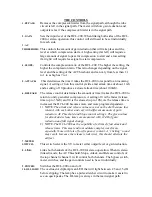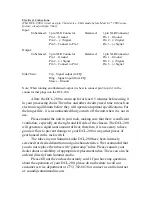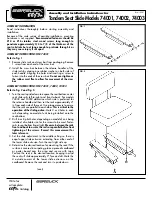
Circuit Explanation
Linking:
The DCL-200 is organized so that in stereo link mode the AC Threshold, Slope, Attack,
and Release controls on the top channel operate both channels. The channel 1 side chain
is fed with the sum of channel 1 and 2 (combined mono signal). The side chain then
generates the controls for both channels. The only problem with this method occurs if the
stereo signal has a large out-of-phase component (180 degrees). This out-of-phase signal
will sum to zero and not generate any gain reduction. Mono compatibility is necessary for
any sound that has the potential for radio or TV play. The DCL-200's method of stereo
linking will work very well when the source is mono compatible.
Attack and Release:
The attack and release settings will change the gain of the side chain. With the attack set
at 10 and release set at 0, a voltage divider circuit is formed creating a low output voltage
to the control circuit. In this case, increase the setting of the AC Threshold control. By
setting the attack at 0 and release at 10, there is no voltage loss in the circuit. The AC
Threshold control will need a much lower setting to achieve the same amount of gain
reduction as in the previous example. By allowing this interaction, you can adjust the
circuit for peak or average responding operation. This allows adjustment of the DCL-200
to deliver a larger variety of smooth sounds.
Audio Path:
The Audio path has a balanced input followed by the gain cell, a tube amplifier, and a
balanced discrete output stage using Dean Jensen designed 990 Op Amps. The 990’s are
arranged so that operation in either balanced or unbalanced mode will result in the proper
gain structure. The tubes are hand selected 12AX7A’s which are tested in circuit and
fully burned in before shipping. They have well regulated power supplies and DC on the
filaments. All amplification is done with the vacuum tubes. The input stage is operated at
a loss to provide the input clipping level of +24dBm.
The gain control device is a proprietary design that synthesizes what the old photo
resistor, light source compressor-limiters did. Our approach allows a much faster
response time, wider bandwidth, and lower distortion. The frequency response –3dB
point is 70kHz and increases as you go into gain reduction. The meter displays the output
signal level as if the DCL-200 is not bypassed, and when the DCL-200 is bypassed, the
tubes are in the signal path.
Summary of Contents for DCL-200
Page 4: ...1 2 4 3 5 6 7 8 9 10 ...




























